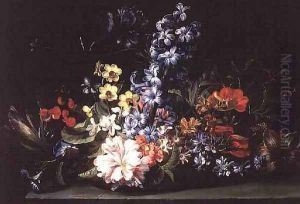Jan van den Hecke Paintings
Jan van den Hecke was a Flemish Baroque painter, draughtsman, and etcher, known for his still life compositions, landscapes, and animal scenes. Born in Kwaremont, near Ronse, in 1620, he became an integral part of the rich tradition of Flemish art during the 17th century, a period marked by intense artistic activity and innovation in the Southern Netherlands.
He was initially trained by his father, Jan van den Hecke the Elder, who was also an artist. Later, he likely continued his education in the workshop of Abraham Hack, which helped him develop a versatile style. Van den Hecke's work was heavily influenced by the prevailing Baroque sensibilities of his time, emphasizing dramatic effects, rich colors, and intricate details.
Throughout his career, van den Hecke enjoyed patronage from notable figures, including the Archduke Leopold Wilhelm of Austria, a prominent art collector and the governor of the Spanish Netherlands. This connection provided him with opportunities to study and copy works from the Archduke's extensive art collection, comprising pieces by the likes of Titian, Paolo Veronese, and Jacopo Tintoretto. This exposure played a significant role in shaping his artistic development and in the refinement of his technique.
Van den Hecke's oeuvre is diverse, encompassing various genres. His still life paintings, particularly those featuring flowers and fruits, are celebrated for their vibrancy and realism. Equally impressive are his landscape and animal scenes, which display a keen observation of nature and a mastery in capturing its essence. Additionally, he ventured into tapestry design, illustrating his versatility and creativity across different media.
Despite his contributions to the Flemish art scene, Jan van den Hecke's name is not as widely recognized as some of his contemporaries. Nonetheless, his works are held in high regard by art historians and collectors, and they can be found in several prestigious museums and private collections around the world. He passed away in Antwerp in 1684, leaving behind a legacy that continues to be appreciated by those who delve into the rich tapestry of Flemish Baroque art.











